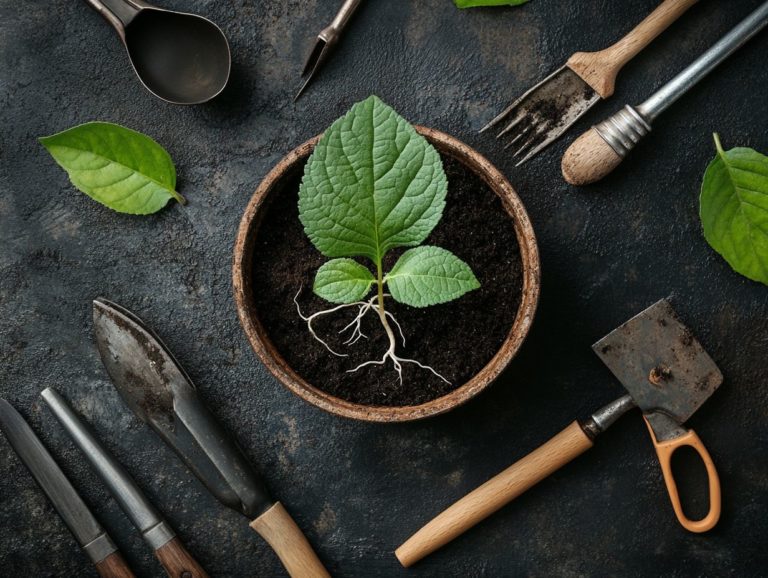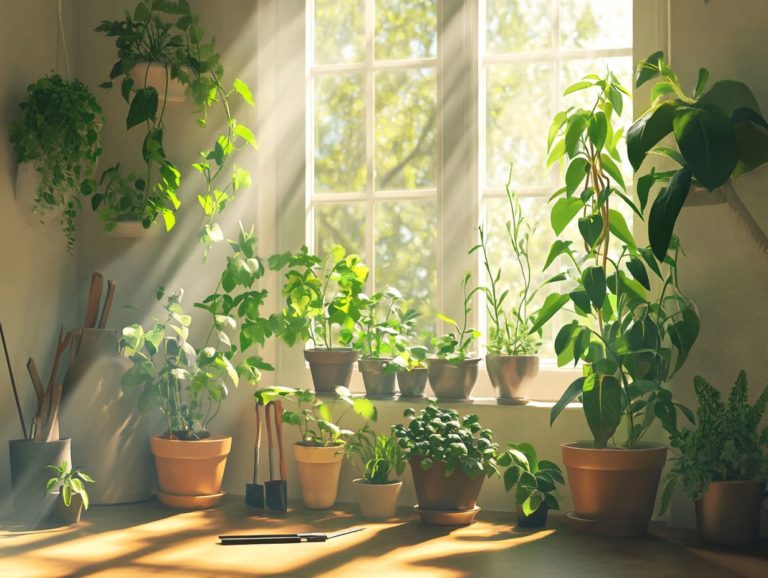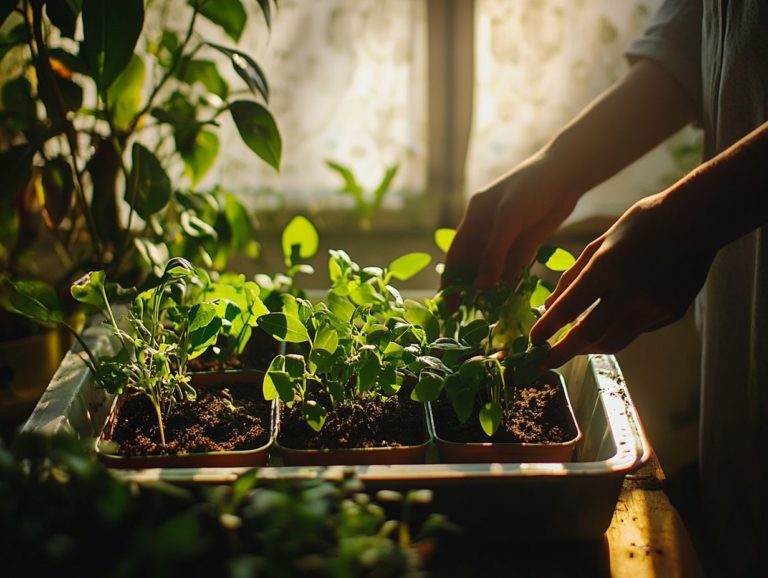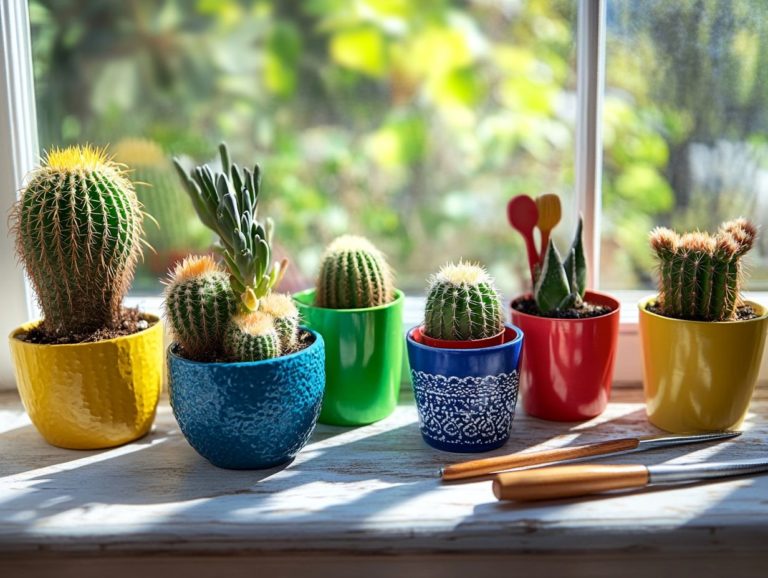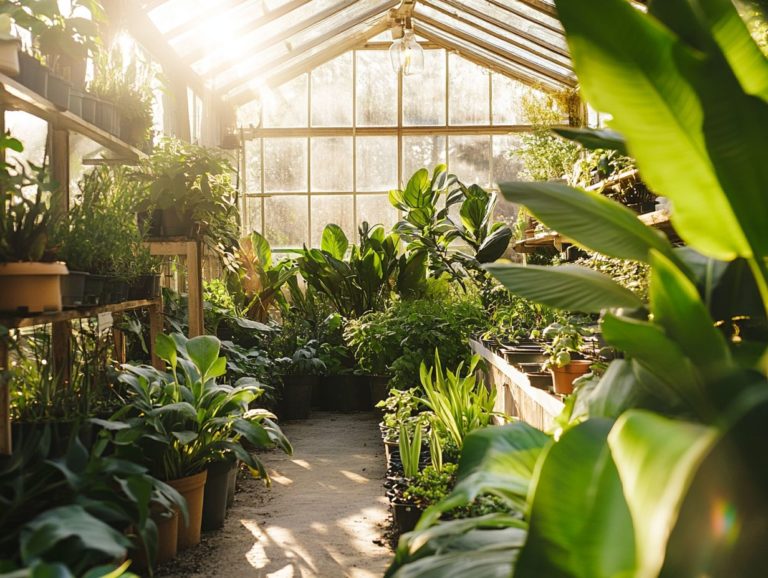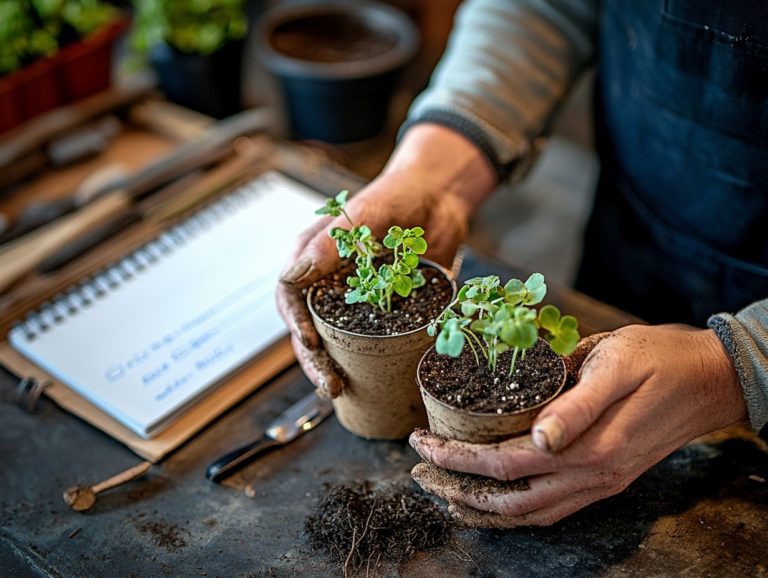The Ultimate Guide to Successful Plant Propagation
Plant propagation is the art of growing new plants from existing ones, a skill that can significantly elevate your gardening experience. Learning how to propagate plants can greatly enhance your gardening.
Whether you aim to expand your garden or share your cherished varieties, mastering propagation methods can truly transform your efforts. This guide will help you navigate both sexual and asexual propagation techniques, including effective cutting methods and the crucial environmental factors influencing your success.
You will also learn to avoid common mistakes, uncover best practices, and troubleshoot challenges to make your plant propagation journey rewarding and fruitful. Immerse yourself in this knowledge, cultivate your skills, and watch your green aspirations thrive, whether you re tending to your houseplants or exploring new varieties like the Monstera Albo or ZZ Plant!
Contents
- Key Takeaways:
- What is Plant Propagation?
- Methods of Plant Propagation
- Factors that Affect Successful Plant Propagation
- Common Mistakes in Plant Propagation
- Tips for Successful Plant Propagation
- Troubleshooting Common Issues
- Frequently Asked Questions
- What is plant propagation and why is it important?
- What are the different methods of plant propagation?
- What are the key factors for successful plant propagation?
- Can all plants be propagated using the same method?
- How can I ensure that my propagated plants are healthy and strong?
- What are some common mistakes to avoid when growing new plants?
Key Takeaways:
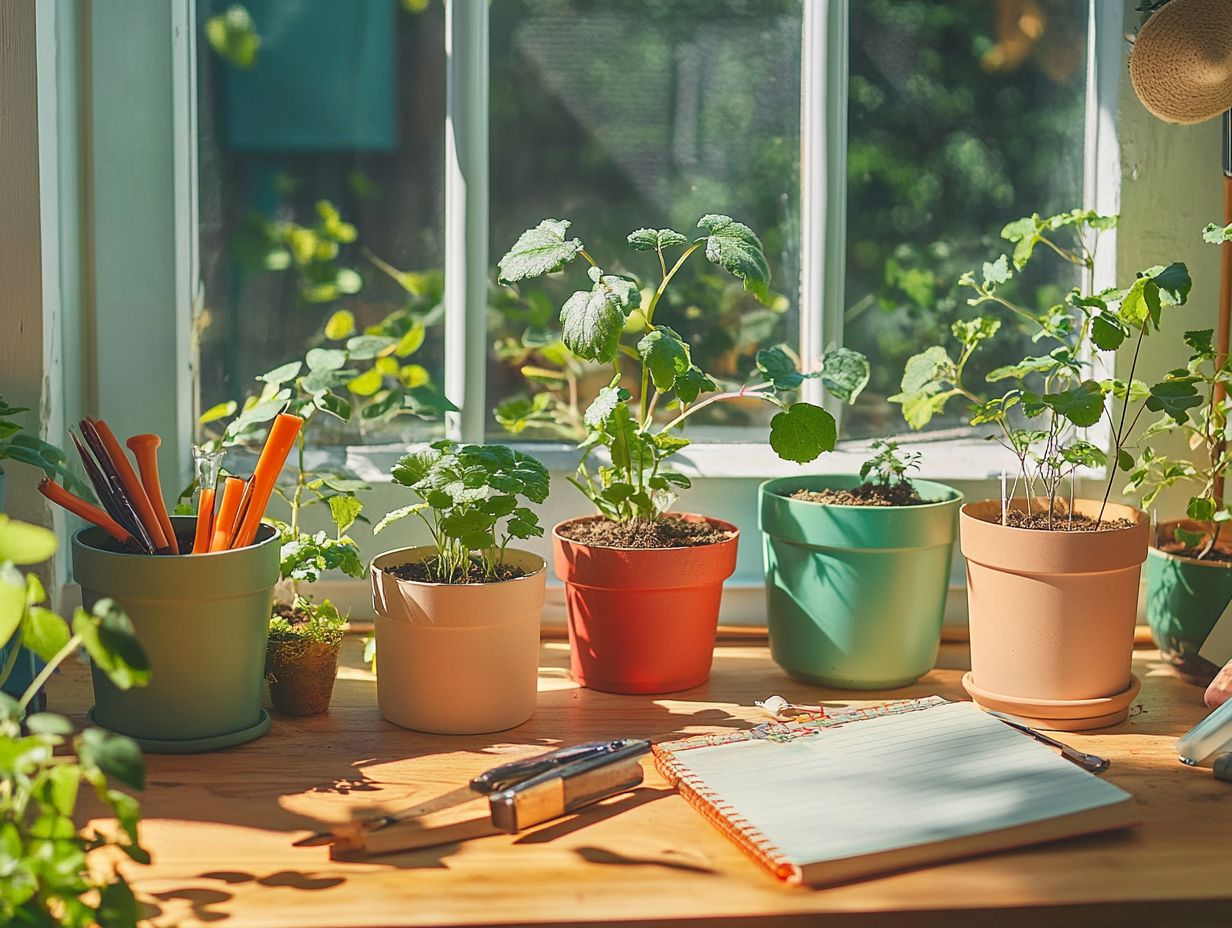
- Master the art of plant propagation by understanding the different methods available, such as sexual and asexual propagation.
- Pay attention to environmental factors, timing, and techniques to increase your chances of successful plant propagation.
- Learn from common mistakes and implement best practices and strategies for successful propagation while troubleshooting any issues that may arise.
What is Plant Propagation?
Plant propagation is a vital process for plant parents, enabling the expansion of your indoor garden. It involves creating new plants from those you already cherish, allowing for delightful growth in your indoor space.
You can explore various techniques, from taking cuttings from mature plants to using seeds for sexual propagation. Each method presents its own unique benefits and challenges, so it s essential to grasp the nuances of successful plant propagation.
Whether you’re a seasoned gardener or just beginning your journey, mastering these techniques can transform your collection of houseplants into a thriving oasis, offering both aesthetic pleasure and a rewarding sense of accomplishment.
Methods of Plant Propagation
You have two primary methods at your disposal for plant propagation: sexual and asexual propagation. Each offers unique benefits for expanding your plant collection, including easy rooting with methods like water changes in clear glass containers.
Sexual propagation involves generating new plants from seeds, which fosters genetic variability the differences among plants that help them adapt and resilience, enriching your garden’s diversity.
On the other hand, asexual propagation, like taking cuttings, allows you to replicate a specific plant s traits without the hassle of seeds, ensuring that the new plants maintain those desirable qualities.
Sexual Propagation
Sexual propagation is the art of generating new plants from seeds, a process that infuses genetic variability and resilience into the offspring. This method aligns with the natural reproductive cycle of plants and introduces delightful diversity that can enhance adaptability to various environments.
Your journey begins with the careful selection of seeds from mature parent plants, ensuring they are ripe and healthy. Once you have your seeds, germinate them in controlled environments, where you can fine-tune factors like temperature, moisture, and light to create the perfect conditions for sprouting, including ensuring indirect bright light for optimal growth.
As seedlings emerge, they will need your attentive care, including proper watering, soil enrichment, and protection from pests. This diligent nurturing will help them develop into strong, vigorous plants that thrive over time.
The genetic variability from sexual propagation significantly boosts adaptability, enabling plants to withstand challenges such as climate change and disease outbreaks. This reinforces the importance of this method in modern gardening and contributes to a robust ecosystem that benefits us all.
Get ready to dive into the exciting world of plant propagation! Start propagating today to see your garden flourish!
Asexual Propagation
Asexual propagation is a popular method for houseplant enthusiasts like you. This involves techniques such as taking cuttings from mature plants to create new specimens that mirror their parent s characteristics. This method is particularly appealing for those interested in varieties like Ficus Elastica Ruby.
This approach is favored for its simplicity. Many houseplants can easily root in water or soil, making it accessible whether you’re just starting out or have a green thumb.
The success of these methods depends on ensuring that your cuttings develop healthy roots, which are essential for the plant’s overall vitality. Among the various techniques, stem cuttings stand out in popularity.
However, keep in mind that factors like the right time of year in March, moisture levels, and the proper size of your cuttings can significantly impact the rooting process.
Once you’ve taken your cuttings, try using a growth hormone, a substance that helps plants grow roots faster, along with maintaining healthy roots to supercharge root growth. After a few weeks, maintaining an ideal environment think humidity and light conditions is crucial to nurture these young plants until they establish their own strong root systems.
Factors that Affect Successful Plant Propagation
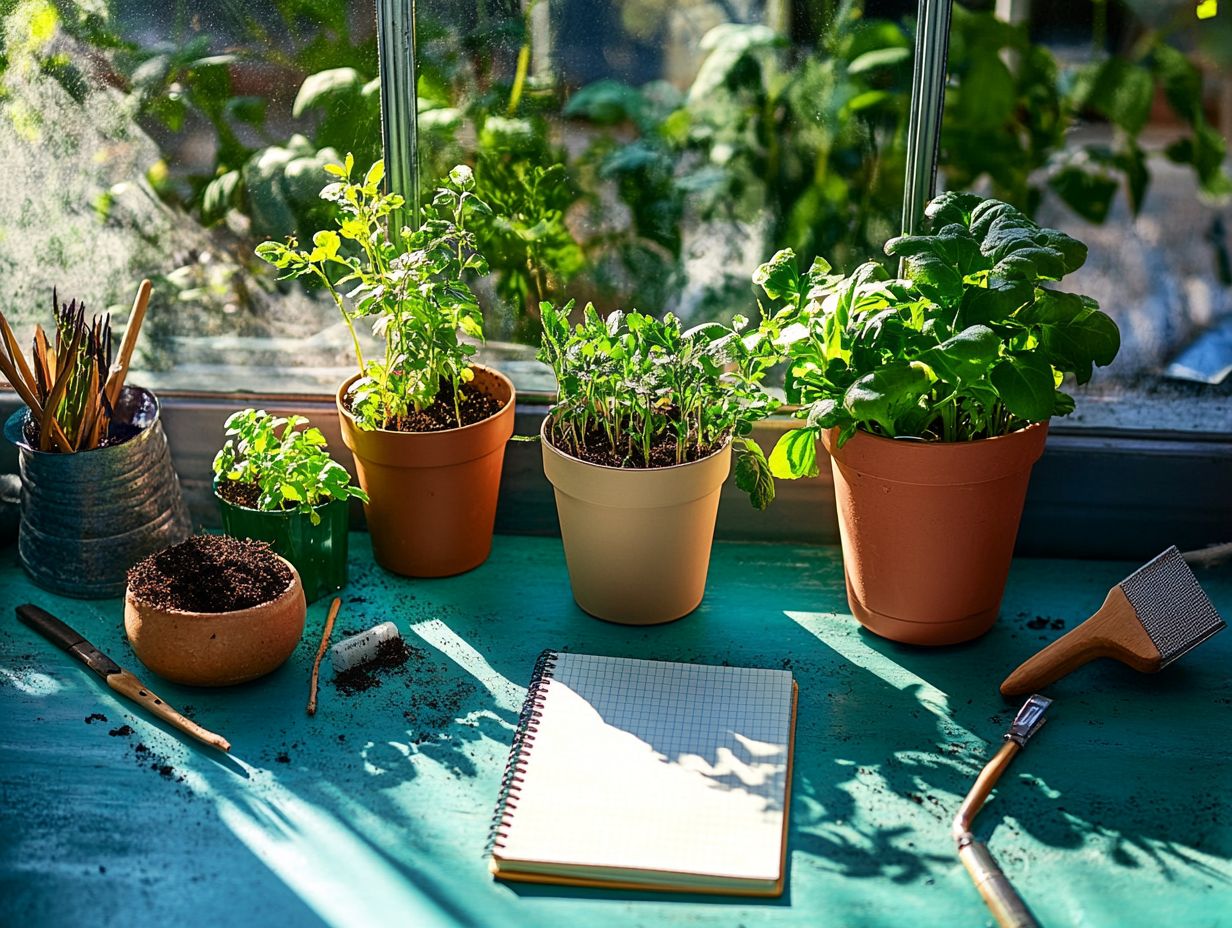
Successful plant propagation hinges on several critical factors, including:
- Environmental conditions
- Timing
- Techniques you choose to employ, such as utilizing DIY propagation stations for your cuttings
Achieving ideal light levels think indirect bright light is essential for nurturing robust root development and ensuring your plants thrive. Making appropriate water adjustments, including regular water changes, is also important.
Grasping these elements can profoundly influence your success rates, whether you re engaging in sexual or asexual propagation, and can be further enhanced by understanding how to propagate from various plant species.
Environmental Factors
Environmental factors are crucial for your success in plant propagation, shaping everything from seed germination to the root development of cuttings. You’ll want to pay close attention to key elements such as:
- Light exposure ideally, indirect bright light
- Temperature settings
- Humidity levels
These elements create the perfect conditions for your new plants to thrive, such as in the case of the ZZ Plant or Wild At Home s indoor gardening tips.
Insufficient light can result in weak or leggy plants, while optimal brightness boosts strong growth and enhances photosynthesis. Maintaining a steady temperature, generally between 65 F and 75 F, is vital; drastic fluctuations can stress your developing plants. Aim for humidity levels around 70-80% to promote healthy root formation and minimize transpiration losses.
If you’re keen on propagating successfully, consider using a humidity dome or misting the environment to keep moisture levels up, ensuring that your cuttings develop healthy roots. Additionally, ensuring good air circulation will help prevent fungal problems and encourage vigorous growth.
By fine-tuning these environmental factors, including utilizing clear glass containers for visibility, you ll set the stage for robust plant development.
Ready to start your propagation journey? Grab your cuttings and watch them thrive!
Timing and Techniques
Timing and techniques are essential for achieving successful plant propagation, as they significantly influence the outcome of your efforts, especially during seasonal changes. Knowing the optimal time of year to take cuttings, particularly in March, or when to transfer seedlings to a suitable environment can make all the difference between flourishing plants and failed attempts.
Understanding seasonal changes is key; spring often emerges as the most favorable season due to increasing light levels and warmer temperatures that stimulate growth.
Use effective methods like soil propagation for moisture-loving plants or water propagation using containers like Mason jars or glass test tubes for the more soil-averse. This choice can markedly enhance your success rates. If you re considering creating DIY propagation stations, opt for clear containers to monitor root development while ensuring proper airflow to prevent pesky mold.
Best practices include regularly misting your cuttings and maintaining the right balance of light and humidity. This enables new growth to thrive in ideal conditions and fosters healthy roots.
Common Mistakes in Plant Propagation
Plant propagation is a thrilling adventure that rewards your patience and care! Yet, it s easy to stumble into common pitfalls that may derail your success. As a dedicated plant parent, it s essential to recognize and avoid these missteps, especially forgetting to change the water.
Whether it s selecting an unsuitable container or neglecting to change the water regularly, being aware of these avoidable errors can greatly increase your chances of nurturing healthy roots and flourishing plants.
Identifying and Avoiding Pitfalls
Identifying and sidestepping pitfalls in plant propagation can significantly boost your success rates, leading to healthy roots and vibrant plants. Common blunders, such as forgetting to change the water in your propagation containers or using unsuitable mediums, can hinder root development and compromise overall plant health.
Improper lighting conditions can stunt growth, resulting in leggy plants that struggle to thrive. Many novice gardeners underestimate the critical role of bright, indirect sunlight, essential for encouraging healthy shoots and preventing leggy plants associated with insufficient light.
Overwatering is another frequent challenge; it can drown seedlings and foster root rot, leaving aspiring plant parents feeling disheartened. To tackle these issues, ensure proper drainage and regularly monitor moisture levels in your propagation containers, especially when using media like perlite or vermiculite to promote airflow.
Utilizing a well-draining propagation medium a growing material that allows excess water to escape, preventing root rot such as perlite or vermiculite, can enhance airflow to the roots, ultimately fostering a more robust root system. By being mindful of these factors, including the importance of clear container monitoring, your journey of nurturing plants can be both fulfilling and successful.
Tips for Successful Plant Propagation
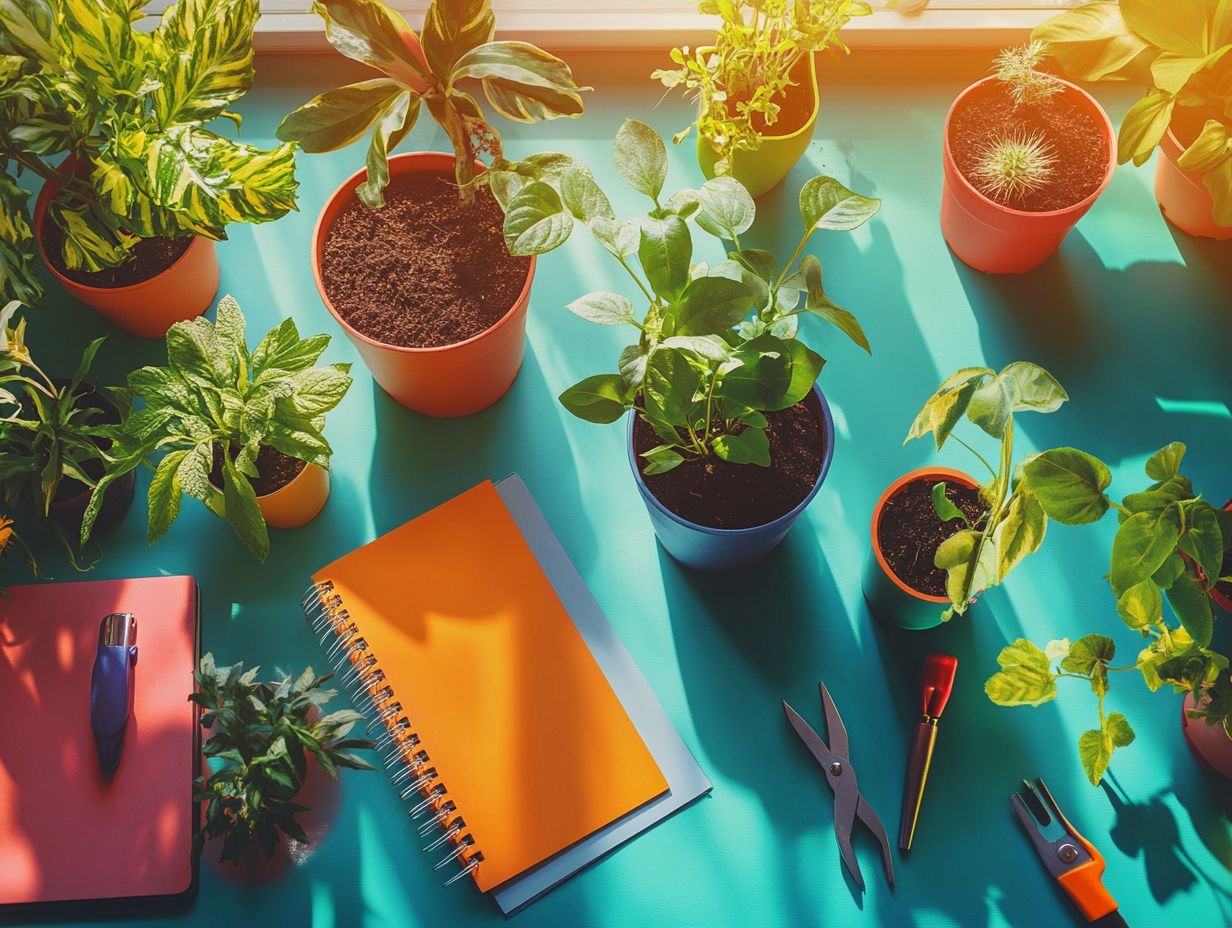
By implementing effective tips and strategies, you can significantly improve your chances of successful plant propagation, whether you’re starting from seeds or cuttings. Embrace best practices such as selecting the right materials, ensuring optimal environmental conditions, and providing consistent care.
This approach allows you, as a dedicated plant parent, to cultivate thriving plants and savor the rewarding experience of nurturing new life.
Start your propagation journey today and watch your plants flourish!
Best Practices and Strategies
Adopting best practices and strategies is essential for your success in plant propagation. This ensures that you achieve the desired outcomes as a dedicated plant parent. Techniques like using a clear glass container for cuttings and ensuring proper light exposure can significantly enhance your chances of successful propagation.
Understanding the specific needs of different species can elevate your propagation efforts. For instance, when propagating Pothos, trimming the stems just below a node the small bump where leaves emerge and placing them in water allows roots to develop efficiently. Meanwhile, the ZZ Plant thrives in drier conditions. Using a well-draining soil mix and allowing the cuttings to dry slightly before planting can help prevent rot.
Maintaining humidity with a plastic bag or dome can create a microclimate that supports healthy root establishment. By implementing these tailored strategies, you can watch your plants thrive like never before!
Troubleshooting Common Issues
Mastering the art of troubleshooting common issues in plant propagation is an essential skill for any discerning plant parent. By honing your ability to address failed propagation attempts, you pave the way for more fruitful endeavors in the future.
When you learn to recognize the signs of trouble like wilting cuttings or stagnant growth you enable yourself to adapt your methods. This ultimately enhances your success rates and fosters a thriving green sanctuary.
Dealing with Failed Propagation Attempts
Dealing with failed propagation attempts can be quite disheartening. However, as a dedicated plant parent, it’s crucial to learn from these experiences to enhance your future efforts. By identifying the root causes of your failures such as inadequate light or improper watering you can refine your approach to nurture healthier roots.
To troubleshoot effectively, recognizing the signs of failure is essential. Yellowing leaves, wilting stems, and a distinct lack of new growth all signal that it s time to make some adjustments. Creating optimal conditions think sufficient humidity, appropriate light levels, and the right soil types will set the stage for a nurturing environment for your plant cuttings.
Don t hesitate to experiment with different propagation techniques, like water propagation versus soil propagation, as these can yield varying results. By taking the time to observe and reflect on each attempt, you ll cultivate a deeper understanding of your plants needs. This paves the way for healthier and more vibrant growth in the future.
Frequently Asked Questions
What is plant propagation and why is it important?
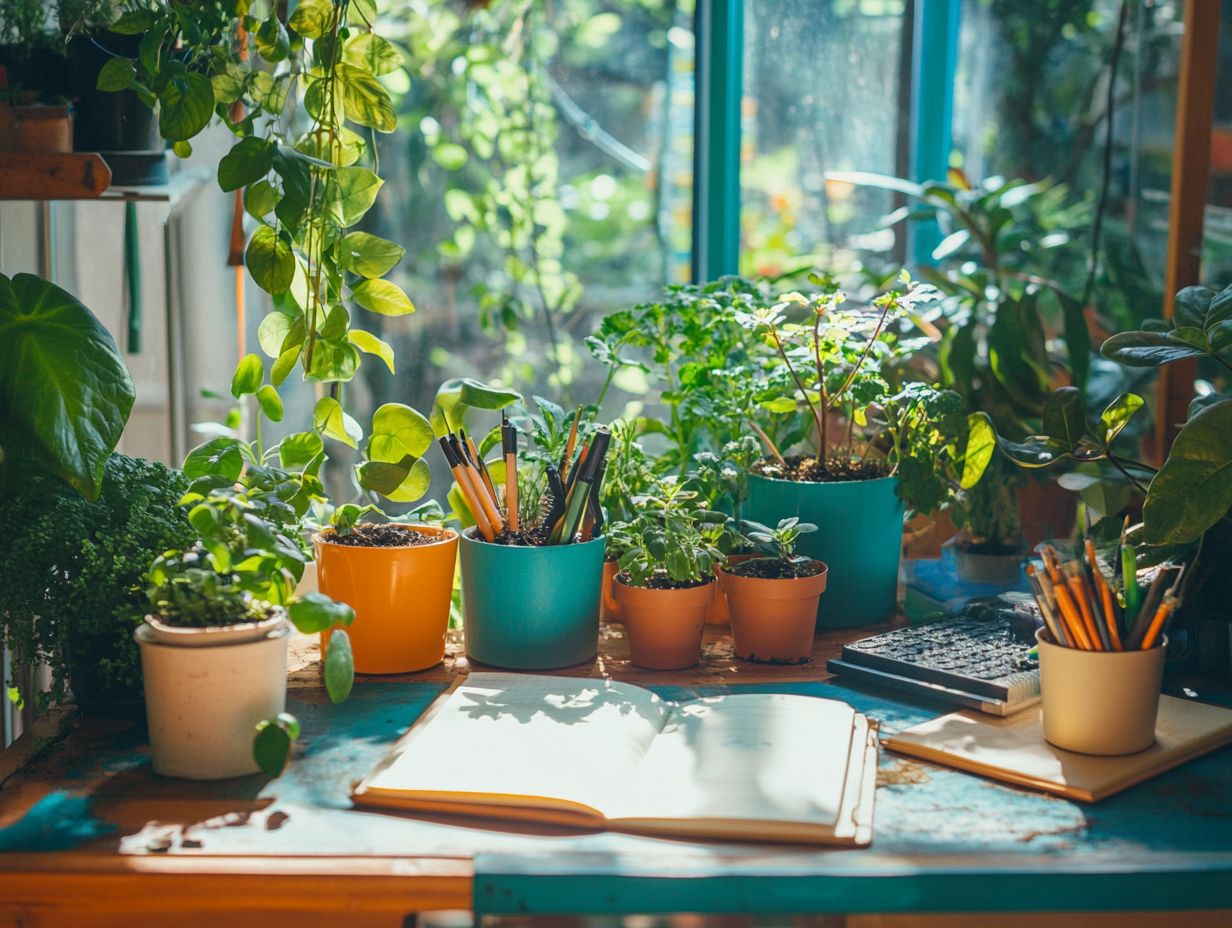
Plant propagation is the process of creating new plants from existing ones. It is important because it allows for the production of more plants, which is essential for gardening, farming, and conservation efforts.
What are the different methods of plant propagation?
The different methods of plant propagation include seed propagation, cuttings, layering, division, and grafting. Each method has its own advantages and is suitable for different types of plants.
What are the key factors for successful plant propagation?
The key factors for successful plant propagation include proper timing, using healthy and disease-free plant material, providing adequate moisture and nutrients, and maintaining optimal temperature and lighting conditions.
Can all plants be propagated using the same method?
No, not all plants can be propagated using the same method. Some plants may be better suited for seed propagation, while others may require a specific method such as cuttings or division.
How can I ensure that my propagated plants are healthy and strong?
To ensure healthy and strong propagated plants, it is important to use high-quality soil and provide adequate care and maintenance. This includes regular watering, fertilizing, and protecting the plants from pests and diseases.
What are some common mistakes to avoid when growing new plants?
Avoid using old or sick plants when growing new ones. Not providing enough light or moisture can also hinder your success.
Be careful not to over-fertilize your plants. Always follow the specific instructions for each method and type of plant to achieve the best results.

